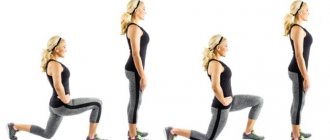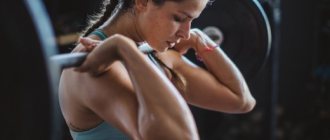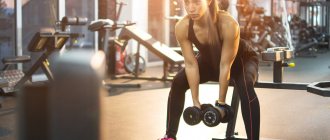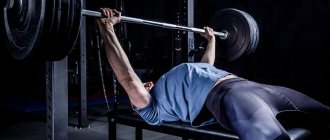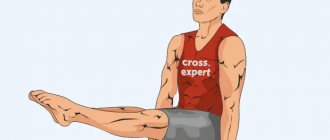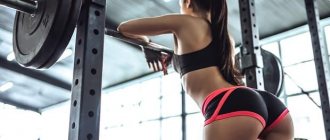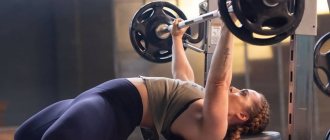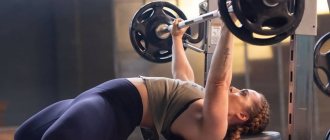Considering that the triceps muscles make up two-thirds of the total muscle mass of the arms, they deserve special attention. The following exercises will make your triceps look impressive!
When it comes to big arms, the biceps are usually the focus. In fact, often bodybuilders do not reach their full triceps development potential. They are “treading water” using the same hackneyed basic exercises.
After studying this material, you can easily assemble training complexes of any complexity. Here is one example of a program that is discussed at the end of the article.
Workout exercises:
- French bench press EZ barbell on an incline bench, 3x10
- Arm extension on a block with a v-shaped attachment, 3x10
- Standing two-arm triceps extension, 3x10
- Reverse grip triceps extension, 3x10
Considering the fact that the triceps muscles make up two-thirds of the total muscle mass of the arms, they deserve special attention. It is these muscles that form beautiful, harmoniously developed arms and set you apart from other athletes. Now is the time to take care of your triceps and first understand a little anatomy.
Triceps anatomy
As the name suggests, “three” implies that this muscle group consists of three heads - lateral (outside), medial (in the center) and long (inside). Medial is the shortest. It is this that forms the desired horseshoe-shaped triceps.
Most of the triceps muscle is located on the humerus, where all three heads connect. For this reason, in order to maximally work these muscles, it is necessary to perform each exercise very well.
There are many exercises for the triceps, but at the same time it is almost impossible to work on each muscle bundle in isolation. However, in any case, in different exercises the work is focused on one or another head.
What muscles does the close grip bench press work?
The main muscle group that the close grip bench press is aimed at is:
- Triceps brachii muscle.
That is, this is our triceps. This exercise uses the full potential of this muscle.
The secondary ones are:
- Pectoralis major and minor muscles
- Anterior delta
- Anterior serratus
If you do the exercise with the correct technique, then these muscles will not prevent the triceps from performing the movement.
And the stabilizers are:
- Back muscles. More precisely, the trapezius and spinal extensors
- Press
What muscles work when bench pressing with a narrow grip?
How to work with exercises
The following complexes of training for triceps were chosen for a reason - the first is aimed at gaining mass and works all three heads. The remaining exercises focus in more detail on each part of the triceps muscle.
Choose a weight so that you can complete the recommended number of repetitions, but the last rep should be the hardest. Rest between sets for as long as possible so that your breathing is completely restored and you are ready to repeat it all again.
Typical execution errors
The technique of performing the French press seems simple at first glance. But only beginners think this way and do this exercise incorrectly.
The main mistake that leads to this common problem is loose elbows. And in two planes at once.
If performed incorrectly, the elbows move forward and backward, and also spread to the sides.
If the elbows are not strictly fixed, then the French press turns into a real pullover. And this is another movement aimed at working out the chest.
Proper technique involves keeping your elbows stationary throughout the entire movement. The shoulders are fixed in the starting position, and only the forearms move up and down.
Also make sure that your elbows do not spread out to the sides. Hands are kept parallel to each other at all times.
This is the only way to ensure maximum load for the triceps, without involving extraneous muscle groups in the movement.
Trying to lift heavy weights is also a fairly common mistake for beginners.
In pursuit of large weights, technique inevitably suffers. In addition, heavy weights on the French press mean an increased risk of elbow injury.
Do not forget that this is an isolating movement, which is not suitable for lifting heavy weights.
Basic triceps exercises in the gym and on the street
The following “classic” compound exercises will serve you well in building muscle structure.
Push-ups on a bench
- Stand with your back to the bench. Rest yourself on the edge of the bench with your arms straight, shoulder-width apart.
- As you inhale, slowly lower your body, bending your elbows. As you exhale, straining your triceps, straighten your arms and lift your body back up.
Push-ups on a bench
Dips
Keep your body at arm's length. As you inhale, slowly lower yourself, keeping your body straight and upright. Bend your arms to a right angle, keep your elbows close to your body. As you exhale, concentrating on your triceps, straighten your arms back.
Dips
Narrow push-ups
Lie face down on the floor and place your arms in a narrow position. As you inhale, lower yourself down almost to the floor; as you exhale, lift your upper body to the starting position. Elbows point back. Hold for a second, then repeat the exercise.
Narrow push-ups
Multi-level push-ups
- Take a lying position so that one hand is located at waist level, and the other under the shoulder joint.
- Bend your arms at the elbow joints until your chest touches the floor and straighten them back. Point your elbows along the body. The whole body should be like a single line.
- Perform the required number of repetitions on one side, then on the other, switching hands.
Multi-level push-ups
Deep triceps push-ups
Place the barbell in a rack position at chest level. Grab the bar with an overhand grip, shoulder-width apart, and step back a little. Lean on the bar with your arms outstretched. Bend your arms and lower yourself towards the bar. The head should be under the bar. Pause and straighten your arms.
Deep triceps push-ups
Exit to straight arms from plank position
Get into plank pose. With your palms on the floor, straighten your elbows and lift your body off the floor. The whole body should be tense. Slowly bending your elbows, lower your forearms to the starting position.
Exit to straight arms from plank position
Recommendations for increasing efficiency
Let's look at the most important conditions for getting the most out of the French press:
- Correct and motionless position of the hands throughout the entire movement
As fatigue accumulates, it becomes increasingly difficult to keep your elbows locked. But you need to constantly monitor this nuance in order to target the triceps and avoid injuries.
- Using adequate weights
In bodybuilding, large muscle groups such as the legs, chest or back are trained with heavy weights. For small muscles, which include the shoulders, biceps, triceps and forearms, use less weight.
For the French bench press, this is rule number one. The appropriate weight ensures ideal technique for performing the exercise, minimizing the risk of injury to the elbows.
- The right pace
Isolation exercises “don’t like” sudden, inertial movements.
A fast pace minimizes the effectiveness of the exercise, removing most of the load from the target muscles.
The optimal pace for performing the French bench press is 2-0-2.
That is, two seconds to lower the barbell down and lift the weight up for two seconds, without stopping at the bottom point.
The result is something like a piston movement, when the weight moves smoothly and under control up and down, without clear fixation and stopping in extreme positions.
This option ensures constant muscle tension in the triceps, increasing the effectiveness of the exercise.
- Boom position in bottom position
The main options are lowering the barbell behind the head (to the level of the crown), to the level of the forehead, bridge of the nose and even the chin. All types of techniques have both pros and cons.
For beginners, it is recommended that you start mastering the French press technique by lowering the bar behind your head, as this is the safest option.
It will be very unpleasant if, due to muscle failure, the barbell falls on the forehead or bridge of the nose. And for beginners, this phenomenon when performing the French press is not uncommon.
Triceps training program. Workout 1
Lying dumbbell extensions (pronated grip)
- 3 sets of 10 reps
- Body part: Triceps Equipment: Dumbbells
Triceps extension down on a block using a rope handle
- 3 sets of 10 reps
- Body Part: Triceps Equipment: Block
Dumbbell back extension
- 3 sets of 10 reps
- Body part: Triceps Equipment: Dumbbells
Extension of arms from behind the head on the lower block
- 3 sets of 10 reps
- Body Part: Triceps Equipment: Block
Add to Calendar * Add to My Workouts * Print Workout
* — The service is in beta testing
The second training option is more technically complex and is recommended for more experienced men to work on their powerful arms. However, both programs will work perfectly for all athletes.
Warm-up
Be sure to do 1-2 warm-up approaches before starting each new movement. This is necessary for the muscles and tendons to warm up, stretch and be ready for a specific movement with working weight. If you don’t warm up first, you can get injured and be out of the training process for a long time.
For isolation exercises, one warm-up approach with half the working weight is enough. For the basic ones, performed at the beginning of the workout, you can do two warm-up approaches, in the first using 1/3 of the working weight and in the second with 2/3 of the working weight. To warm up, 8-10 repetitions are enough.
Triceps training program. Workout 2
French press EZ barbell on a negative incline bench
- 3 sets of 10 reps
- Body part: Triceps Equipment: Barbell
Arm extension on a block with a v-shaped attachment
- 3 sets of 10 reps
- Body Part: Triceps Equipment: Block
Standing two-arm triceps extension
- 3 sets of 10 reps
- Body part: Triceps Equipment: Dumbbells
Reverse grip triceps extension
- 3 sets of 10 reps
- Body Part: Triceps Equipment: Block
Add to Calendar * Add to My Workouts * Print Workout
* — The service is in beta testing
Once you feel comfortable with the proposed combinations of exercises, you can study further ideas and universal keys to success in pumping and pump up strong forearms to ideal shapes.
Contraindications
The French bench press with a barbell is a physically simple exercise. In addition, the body easily tolerates the training load on the triceps, recovering quickly.
It is suitable for almost any level of fitness and health.
The only, but very serious, limiting factor is diseases or injuries of the elbow joints and ligaments.
If the French bench press causes pain or even mild discomfort, eliminate it from the program and try gentler alternatives.
